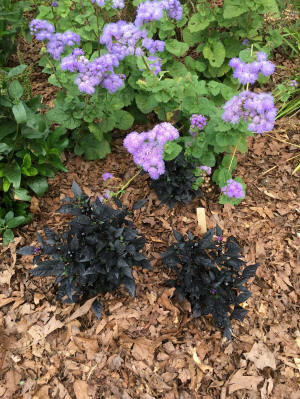|

Be a Waterwise Gardener
By Melinda Myers
[April 05, 2025]
Too much or not enough water and never when your
garden needs it. This is a common complaint of gardeners no matter
where they live. Make a few changes in your plant selection and
garden care to help manage water use while growing healthy plants.
All plants need sufficient moisture after planting
and for several months to a year or two to develop a robust root
system. Those labeled as drought tolerant are better able to
tolerate periods of drought once established. Always water the area
surrounding new plantings thoroughly when the top few inches of soil
are crumbly and moist. Gradually reduce the frequency, and once the
plants are established, you’ll need to water less often. |
|
Moisture-loving plants are good choices for areas
receiving sufficient and consistent moisture throughout the growing
season to meet their needs. In locations where this is not the case,
consider grouping moisture-loving plants together so you use less
water and can concentrate watering efforts to just one or two
locations in your landscape.
Fluctuating periods of excessive and insufficient rainfall add to
the challenge. Many native plants, once established, tolerate
periods of wet and dry soil and can be found on lists of rain garden
plants suited to your area.
Keep water in the garden, out of the storm sewers, and reduce the
risk of flooding while improving your garden. Adding several inches
of compost to the top 8 to 12 inches of soil increases the soil’s
ability to absorb and retain water. It also improves drainage in
heavy soils.
Top dress existing gardens by spreading an inch of compost over the
soil surface. Soil organisms will help move it into the soil to
improve plant growth. Lend nature a hand by using an auger bit on a
drill to aerate compacted soil. This pushes some compost into the
top four to six inches of soil.
Mulching the soil with leaves, evergreen needles, or other organic
matter also helps. This task has many benefits, including conserving
moisture, reducing the risk of erosion and compaction, suppressing
weeds, and as the mulch decomposes, improving the soil. A
one-to-three-inch layer over the soil surface is all you need. The
finer the mulch material, the thinner the layer of mulch that is
needed.
Collect rainwater in rain barrels or cisterns when it is plentiful
and store it until needed. Use this to water ornamental containers
and plantings. Always check with your municipality first, since some
restrict this practice while others offer rebates or rain barrels at
a discounted price.
You won’t need to worry about mosquitoes breeding inside your rain
barrel if you place an organic mosquito control product like
Mosquito Dunks® (SummitResponsibleSolutions.com) in rain barrels and
other water features. Mosquito Dunks provide 30 days of control, are
natural and organic, and won’t harm pets, fish, wildlife, or
children.
[to top of second column] |

Periods of heavy rainfall create another challenge.
Covering the soil with plants and mulch helps protect your soil from
compaction and erosion that often happens during these events.
Planting trees, shrubs, and groundcovers will slow the flow of
rainwater, increase the amount of water that stays in your landscape
for plants to use, and help filter dust and pollutants out of
rainwater before it enters groundwater.
Rain gardens are another strategy for managing water in your yard.
These are designed to capture excessive rainfall, drain within 24 to
36 hours, tolerate dry and wet periods, and filter pollutants from
the rainwater before it enters the groundwater.
Start by incorporating one or more of these strategies to help
manage rainwater in your landscape. Continue to monitor success,
adapt as needed, and include more options to help you successfully
garden even during periods of excessive or limited rainfall.
Melinda Myers has written more than 20 gardening books,
including the Midwest Gardener’s Handbook, 2nd Edition and Small
Space Gardening. She hosts The Great Courses “How to Grow Anything”
instant video and DVD series and the nationally syndicated Melinda’s
Garden Moment TV & radio program. Myers is a columnist and
contributing editor for Birds & Blooms magazine and was commissioned
by Summit for her expertise to write this article. Myers’ website is www.MelindaMyers.com.
[Photo courtesy of MelindaMyers.com]
 |